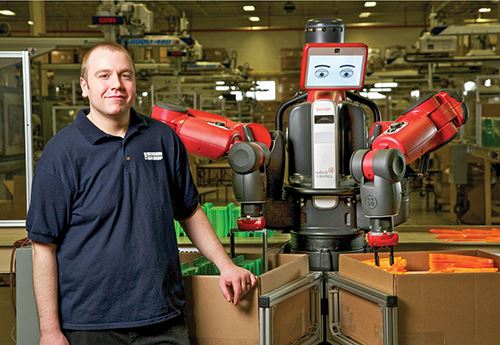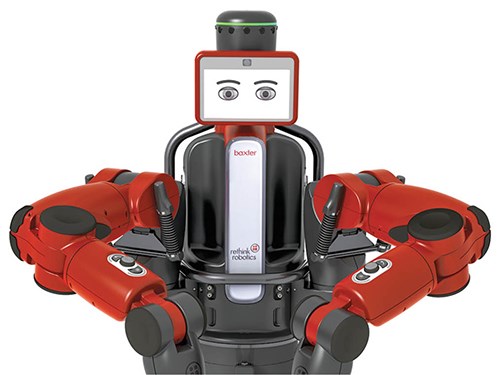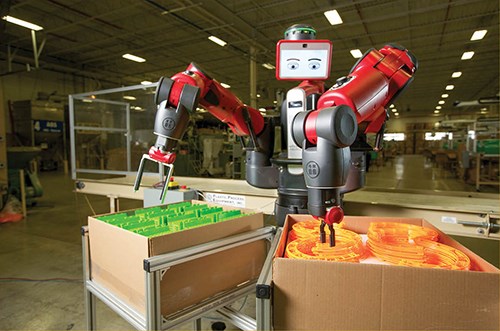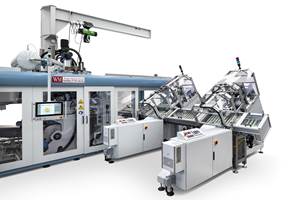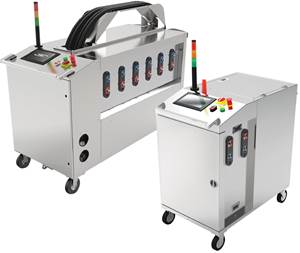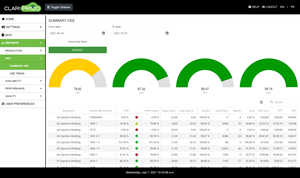‘Collaborative’ Robot Works Alongside Human Workers
The goal of Baxter's builder is to make U.S. manufacturing more globally competitive by making automation more affordable and easier to implement.
The company name says a lot about its products. Rethink Robotics is a five-year-old, Boston-based company that makes what it calls “a different kind of robot.” The device has a deliberately anthropomorphic look, with two multi-joined arms on a columnar “body,” an expressive pair of humanoid eyes, and a friendly-sounding name, Baxter. All of this might sound a bit cutesy to a no-nonsense process engineer, but Baxter is designed with a serious purpose in mind.
The goal is to make U.S. manufacturing more globally competitive by making automation more affordable and easier to implement, so that valuable employees can be freed from simple repetitive tasks and devoted to more value-added jobs. Baxter is not for high speed and precision, but for repetitive pick-and-place tasks that don’t require expensive human labor.
Baxter is designed to be implemented quickly and easily with no programming skills, to work safely beside human workers, to communicate with them in a simple and intuitive fashion, to be self-guided by means of built-in sensors, and on top of all that, to have a relatively low price point.
Safety is one of the key principles of Baxter’s design. It incorporates 360° sonar and a front-facing vision system to detect human presence and also to perform its tasks. It can “see” in 3D, sensing height and distance. With vision, it can detect objects on a conveyor, for example, and count parts as it packs them into containers. Baxter’s “servo-elastic” control prevents harmful collisions: If one of its arms meets resistance force of less than 1 lb, it will stop—and then continue on its path when the resistance is removed.
Simplicity is another key principle. Baxter is a complete system of hardware, software, controls, user interface, safety, and sensors; it needs no integration. Take it out of the box, and Baxter can be trained and working in under an hour, the company says.
Baxter “learns” tasks by lead-through teach programming: With very light pressure, a worker guides its arms through the desired motions and presses a button to actuate the grippers at the desired positions. Each arm has seven servo-driven axes. The unit is powered by 120V.
Rethink Robotics describes Baxter as a “collaborative robot.” Baxter’s “face” is a small LCD screen with two eyes depicted on it. Those eyes follow the task the robot is currently focused on. They have several different expressions intended to help workers understand Baxter’s “state of mind,” so to speak. For instance, a confused look, with raised eyebrows, signals a problem, and the eyes turn to the arm that needs attention.
The Rodon Group, a large custom and proprietary injection molder in Hatfield, Pa., is one of the first plastics companies to employ Baxter. It uses the robot to pick parts off a conveyor and pack them into a box in layers—just the sort of task Baxter was designed for. Lowell Allen, Rodon’s sr. v.p. of manufacturing, is happy with Baxter’s performance and expects to get more like him. “Conventional robots require guarding because they can be dangerous,” Allen says, “but Baxter is designed to work alongside people without need for protective guarding.” He also likes that Baxter can be taught jobs by ordinary line workers with no programming knowledge. The “collaborative” aspect is useful, too: Baxter’s semblance of a face “makes it easier for workers to accept,” Allen says.
Related Content
Automation in Thermoforming on the Rise
Equipment suppliers’ latest innovations exemplify this trend driven by factors such as labor shortages, higher-speed thermoformers and tighter quality control.
Read MoreSystem Offers 'Lights Out' Mold-Channel Cleaning & Diagnostics
New system automatically cleans mold-cooling lines—including conformal channels—removing rust and calcium, among other deposits, while simultaneously testing for leaks, measuring flow rate and applying rust inhibitor.
Read MoreReal-Time Production Monitoring as Automation
As an injection molder, Windmill Plastics sought an economical production monitoring system that could help it keep tabs on its shop floor. It’s now selling the “very focused” digital supervisor it created, automating many formerly manual tasks.
Read MoreScaling New Heights With Vertical Integration
Eden Manufacturing was founded on a vision of vertical integration, adding advanced injection molding capabilities to a base of precision moldmaking and more recently bringing Swiss-type machining capabilities in-house.
Read MoreRead Next
See Recyclers Close the Loop on Trade Show Production Scrap at NPE2024
A collaboration between show organizer PLASTICS, recycler CPR and size reduction experts WEIMA and Conair recovered and recycled all production scrap at NPE2024.
Read MorePeople 4.0 – How to Get Buy-In from Your Staff for Industry 4.0 Systems
Implementing a production monitoring system as the foundation of a ‘smart factory’ is about integrating people with new technology as much as it is about integrating machines and computers. Here are tips from a company that has gone through the process.
Read More

